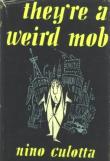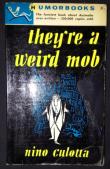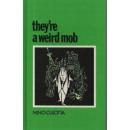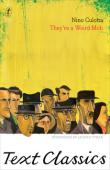
Latest Issues
AbstractHistoryArchive Description
'Who the hell’s Nino Culotta. That’s what you asked yourself when you first picked up this book, wasn’t it? Well I’m Nino Culotta. My father baptised me Giovanni—John—well Giovannino is like Johnny, and Nino is an easier way of saying it. Or a lazier way, if you like.
'Just off the boat from Italy—the north—Nino Culotta arrives in Sydney. He thought he spoke English but he’s never heard anything like the language these Australians are speaking.
'They’re a Weird Mob is an hilarious snapshot of the immigrant experience in Menzies-era Australia, by a writer with a brilliant ear for the Australian way with words.' (Publication summary : Text Classics)
Adaptations
-
form
y
 They're a Weird Mob
Sono Strana Gente
( dir. Michael Powell
)
United Kingdom (UK)
Australia
:
Williamson-Powell International
,
1966
Z553582
1966
single work
film/TV
humour
(taught in 6 units)
They're a Weird Mob
Sono Strana Gente
( dir. Michael Powell
)
United Kingdom (UK)
Australia
:
Williamson-Powell International
,
1966
Z553582
1966
single work
film/TV
humour
(taught in 6 units)
Italian sports journalist Nino Culotta is lured to Sydney during the mid-1960s to work for his brother's new magazine for migrant Italians. When he arrives in the country, however, Nino finds out that there is no magazine and that his brother has taken off with the investors' cash. Left in the lurch is his brother's business partner, Kay Kelly. Nino vows to pay off his brother's debt and gets a job as a builder's labourer. In doing so, he learns how to talk, act, and drink like an Australian male. His numerous attempts to woo Kay are repeatedly rebuffed with humorous results, but in the end she falls in love with him. Nino's introduction to the country and its culture finds him bemused but ultimately confident that he has a future here.
The Australian Centre for the Moving Image suggests this film is 'very much a product of the assimilationist view dominating Australian immigration policy at the time'.
Notes
-
Dedication: This is a work of fiction, and is dedicated to all Australians who work with their hands, in gratitude for their very real contributions to my education. Anyone who thinks he recognises himself in these pages probably does. N.C.
-
David Carter's 'Case-Study: They're a Weird Mob and Ure Smith' in Paper Empires a History of the Book in Australia 1946-2005, ed. Craig Munro and Robyn Sheahan-Bright (2006): 24-30 reports that by 1981 there had been 47 impressions and an estimated 940,000 sales of the work.
Contents
- Introduction, essay
Publication Details of Only Known VersionEarliest 2 Known Versions of
Other Formats
- Sound recording.
- Braille.
Works about this Work
-
“Friendship, but Bloke-ier” : Can Mateship Be Reimagined as an Inclusive Civic Ideal in Australia?
2022
single work
criticism
— Appears in: Journal of Australian Studies , vol. 46 no. 2 2022; (p. 196-210)'In 1999, John Howard attempted to insert the word “mateship” into the Constitution, arguing that it had been reimagined as an inclusive national ideal. This article looks at the history and meaning of mateship, followed by a discussion of contemporary Australian attitudes towards it. The data we use in this article is from a voluntary survey (the Australian Mateship Survey) conducted by the authors, which asked respondents (N = 576) how they define mateship and how they feel about the term. The results indicate that a majority think mateship is a key feature of Australian identity but have concerns when the idea is politicised. A sizable minority believe the term is gendered and racialised and, therefore, is not inclusive of all Australians. Further, the survey suggests that a wide range of opinions exists even among those who do believe mateship has national significance. Twenty years after Howard’s attempt to enshrine mateship in the Constitution, this article suggests that the concept remains too divisive to serve as a core Australian value.' (Publication abstract)
-
Island Stories
2020
single work
autobiography
— Appears in: Griffith Review , no. 69 2020; (p. 52-59) Inside Story , July 2020; Sandy and Beryl Stone had 'a really lovely night's entertainment One ' Tuesday in Melbourne in the late 1950s — according to Barry Humphries's brilliant 'Sandy Stone' satire of Australian suburban life — when they attended a picture night at the tennis club. 'The newsreel,' Sandy reported, 'had a few shots of some of the poorer type of Italian housing conditions on the Continent and it made Beryl and I realise just how fortunate we were to have the comfort of our own home and all the little amenities round the home that make life easier for the womenfolk, and the menfolk generally, in the home.' (Introduction)
-
y
 Always Almost Modern : Australian Print Cultures and Modernity
Melbourne
:
Australian Scholarly Publishing
,
2013
6479433
2013
multi chapter work
criticism
Always Almost Modern : Australian Print Cultures and Modernity
Melbourne
:
Australian Scholarly Publishing
,
2013
6479433
2013
multi chapter work
criticism
'Was Australian culture born modern or has it always been behind the game, never quite modern enough? Was it always already or only always almost modern? David Carter’s essays examine the complex engagements of Australian writers, artists, editors and consumers with 20th-century modernity, social and political crisis, and the impact of modernisms. Always Almost Modern ranges from the great mid-century novels of authors such as Eleanor Dark and M. Barnard Eldershaw to the unprecedented bestseller that was They’re a Weird Mob, from famous to largely forgotten local magazines and to film and television, and from the avant-garde to nationalism, communism and the middlebrow. Chapters engage with key themes in contemporary literary and cultural studies, exploring new ways of understanding Australian culture in terms of its modernity and transnationalism.' (Publisher's blurb)
-
The Beginner's Guide to Being an Australian : John O'Grady's They're a Weird Mob
2012
single work
criticism
— Appears in: Republics of Letters : Literary Communities in Australia 2012; (p. 239-247) 'Lindsay Barrett interrogates the remarkable effectiveness of Jon O'Grady's They're a Weird Mob - Australia's most popular novel of the 1950s - in negotiating for middlebrow Australian readers the tensions that had arisen between an older version of the 'imagined community' and the new, physical community brought into being by postwar migration. In this sense, Barrett argues, it was 'an intensely ideological work of fiction'. (Kirkpatrick, Peter and Dixon, Robert: Introduction xviii) -
Hoaxing Jokes : Unveiling (Un)canny Ethnic Hoaks
2012
single work
criticism
— Appears in: Journal of the European Association of Studies on Australia, , vol. 3 no. 2 2012; (p. 90-104) 'This article deals with two ethnic hoaxes - O'Grady's They're A Weird Mob and Demidenko's The Hand that Signed the Paper - examining their reception in the Australian literary market through the lens of Freud's theory of the comic and the joke. Focusing on etymological implications of the comic and the joke, their respective containing and rupturing effects and how these interlink colonial, assimilationist and multicultural discourses in Australia will be pointed out. Apart from revisiting the social and literary backgrounds of the novels this will cast light on their similar perpetuation of binary oppositions which de-aestheticise the inferior "other" in favour of the superior "White" subject. On the other hand, the comic-joke relationship will be useful in order to interpret the psychoanalytical reasons for the diametrically opposite reception the novels received after the hoaxes were unveiled. This reception was due not merely to the different content of the novels but also to the locus of the comic. In They're a Weird Mob the comic is embedded inside the text, thus containing the rupturing effect of the joke, which reveals the mimicral relationship between the two subjects of the above binary opposition and, thus, the post-colonial/post-multicultural "similarity" between them, even after the hoax was revealed. However, in Demidenko's case the locus of the comic is to be found in its epitextual elements which meant that, once the hoax was discovered, the joke with its psychoanalytical meanings and fears haunted the "White" subject in the open, rupturing such a subject's putative superiority. It is with the latter meaning that the neologism "hoaks" is used in this article; that is, to sum up the idea that ethnic hoaxes play on the slippery psychoanalytical ground of the comic and the joke, of superiority and its opposite, uncanny fears.' (Author's abstract)
-
[Review] They're a Weird Mob
2012
single work
review
— Appears in: The Lifted Brow , no. 14 2012; (p. 24)
— Review of They're a Weird Mob 1957 single work novel -
Howyergoin'mate
1957
single work
review
— Appears in: The Bulletin , 18 December vol. 78 no. 4062 1957; (p. 59)
— Review of They're a Weird Mob 1957 single work novel -
A Gimmick Book?
1958
single work
review
— Appears in: Overland , Winter no. 12 1958; (p. 38-39)
— Review of They're a Weird Mob 1957 single work novel -
[Review] They're a Weird Mob
1958
single work
review
— Appears in: Overland , Winter no. 12 1958; (p. 38-39)
— Review of They're a Weird Mob 1957 single work novel -
[Review] They're a Weird Mob
1958
single work
review
— Appears in: Meanjin , Winter vol. 17 no. 2 1958; (p. 216-217)
— Review of They're a Weird Mob 1957 single work novel -
O'Grady, John see 'Culotta, Nino' : Popular Authorship, Duplicity and Celebrity
2004
single work
criticism
— Appears in: Australian Literary Studies , October vol. 21 no. 4 2004; (p. 56-73) Always Almost Modern : Australian Print Cultures and Modernity 2013; (p. 215-231) -
Laying Our Cultural Foundations
2007
single work
criticism
— Appears in: The Age , 17 November 2007; (p. 19) -
'Australia Cane' - Fifty Years Later
2007
single work
criticism
— Appears in: Literary and Social Diasporas : An Italian Australian Perspective 2007; (p. 31-38) -
A Hard, Dry Humour for a Hard, Dry Land
1988
single work
criticism
— Appears in: Constructing a Culture : A People's History of Australia Since 1788 1988; (p. 156-169) -
A White Australia
2008
single work
criticism
— Appears in: Making Australian History : Perspectives on the Past Since 1788 2008; (p. 256-287)
- Sydney, New South Wales,
- 1950s







